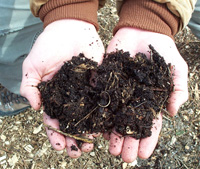 |
||
Ron’s ArticlesHealthy Garden, Happy ManJanuary 2006
Your neighbors may think you’ve lost your mind when they see you hauling around what looks like dark dirt and then raking it into your turf. But, I guarantee that they’ll be envious next spring when your turf has fewer weeds and is greener and your flowers, shrubs and trees are blooming like crazy. And, you’ll be enjoying a healthier landscape and lower water bills for years to come. My recommendation is based on scientific research that proves that organic beats synthetic on every dimension. The dictionary defines organic as simple, helpful, close to nature and consisting of carbon which is fundamental to life. And, it describes synthetic as manmade, not of natural origin, fictitious or bogus. Stop using any synthetic fertilizers. If you’re lucky, the worst thing they contain is salt. When watered, synthetic fertilizer forms a gaseous chlorine cloud that destroys beneficial symbiotic life in the soil and lays waste to carbon - the essence of life. Compost is a fundamental component of organic gardening. Apply fully digested compost at the rate of one cubic yard per 1,000 square feet. That’s a layer of compost about 1/3-inch thick. You’ll improve the organic content of the soil substantially. Any compost will do some good, but we’ve researched this to come up with what we believe to be the best blend. We mix 50% wood with 50% biosolids aka refined sewer sludge. That idea disturbs some people, but their concerns are totally unwarranted. According to the National Institute of Environmental Health Sciences, biosolids resemble sewer sludge just about as much as plastic grocery bags resemble the crude oil from which plastic is derived. I prefer biosolids to animal manure because they are the only regulated compost material. Before they are released from the sewage treatment plants, they are tested and certified to be disease and pathogen free. Bed Preparation All beds should be mulched with 2 to 3-inches of mulch. Double ground cedar is best It contains mild insect and disease inhibitors, plus as it breaks down, it helps to acidify the soil and counterbalance the alkalinity of treated water. An application of compost will give you 12 pounds of slow release nitrogen and all the trace minerals and elements needed to sustain your turf for the coming year. Every time it rains or you water, compost provides the soil with a healthy dose of nutritious compost leachate. Compost inoculates your property with billions of microbes. The organic material coupled with the microbial activity converts lifeless soil to a soil rich in decomposing organic matter known as humus. Humus produces humic acids that slow down and stop weed seed germination. Weed seeds can lay dormant in the soil for hundreds of years. They come to life only when the soil is in poor condition. Humus acts like a sponge. It helps your soil absorb and hold moisture thereby reducing your water requirements by up to a third in the very first year. Reducing your watering has benefits beyond lower utility bills. Frequent use of treated municipal water depletes nutrients, strips mineral content and kills the beneficial life in the soil. I recommend that you turn off your automatic sprinkler. There is nothing automatic about Texas weather. Use your finger. Push the manual start button when you see clear signs that your landscape needs water. By holding back on the water, you force your plants - grass, shrubs and trees to make an extra effort to reach for water deeper. Organic gardening practices mimic nature. Think of it. In the fall the leaves fall which, if left undisturbed, blanket the soil and slowly decompose throughout the winter returning nutrients to the soil. By applying compost, we’re giving the natural process a head start. Remember, a healthy garden and a happy man both go hand in hand, but with more God and less man. 
|
|
|


|
||

 For a new bed the best approach is to excavate the top two inches of the soil. Then lay out 4-inches of compost and 2-inches of expanded shale. Expanded shale is a simulated volcanic material that is paramagnetic. Because of its consistency, it is producing better results than the lava sand I’ve recommended in the past. And, it’s less expensive. Till this material into the top 6-inches of soil. For existing beds, an inch of compost worked into the top inch of soil will work well.
For a new bed the best approach is to excavate the top two inches of the soil. Then lay out 4-inches of compost and 2-inches of expanded shale. Expanded shale is a simulated volcanic material that is paramagnetic. Because of its consistency, it is producing better results than the lava sand I’ve recommended in the past. And, it’s less expensive. Till this material into the top 6-inches of soil. For existing beds, an inch of compost worked into the top inch of soil will work well.